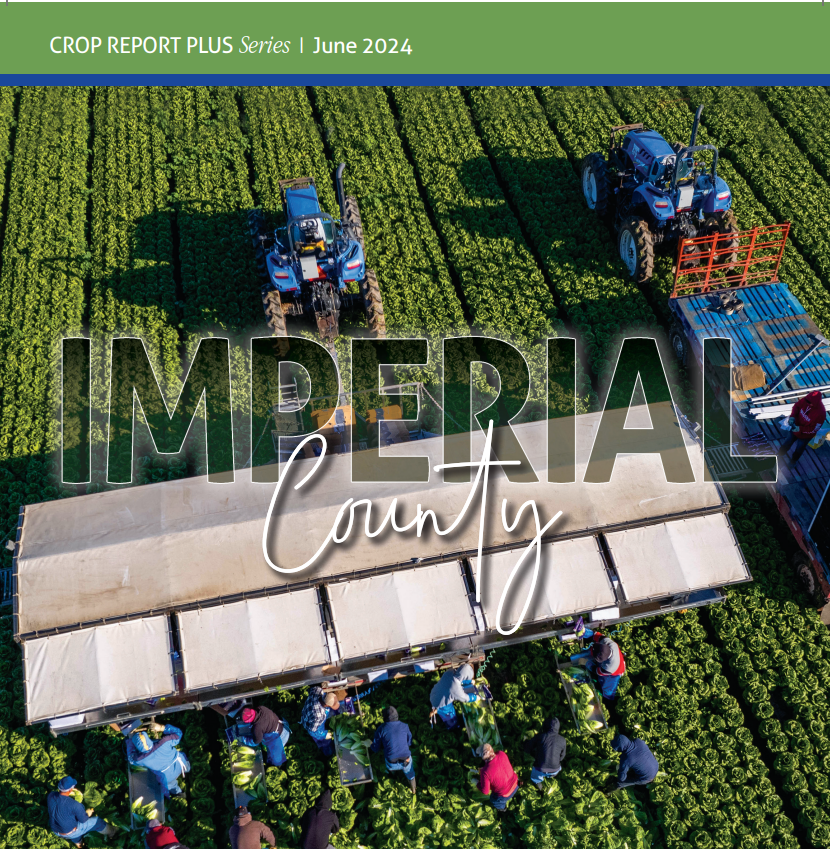
Recently, the Imperial County Agricultural Commissioner’s Office (ICACO) released its 2024 Crop Report Plus document, which measures the impact—direct, indirect and induced (all terms pertinent to the report)—that agriculture has on the county’s economy. The Crop Report Plus is produced about every three years and is in addition to the county’s annual Agricultural Crop and Livestock Report. In short, the Crop Report Plus takes a deeper dive into agriculture’s broader contribution to the local economy, going beyond crop production values and employment numbers (direct) by also exploring local inter-industry, business-to-business supplier purchases (indirect), and local consumption spending by employees (induced). This is the third in a series of Crop Report Plus documents released—the first two were released in 2017 and 2021. While the numbers in the latest report do not tell the entire story of the challenges farmers and ranchers in the Valley face, what they show is sustained growth in agriculture and the ability growers and ranchers have to adapt to changing dynamics.
When the Crop Report Plus was presented to the Imperial County Board of Supervisors this month, grower Mark McBroom, who chairs the Imperial Irrigation District’s Agricultural Water Advisory Committee (but was speaking as an individual grower), was present to comment on the report. “What it shows is the value of what farming brings to the community, but what it also shows ultimately is that the generator of that farm is water, and that really gets back to the baseline of where your water is at and what the value of that water is.”
In a comment to this blog, McBroom also said, “The Imperial Valley growers have been able to survive and successfully navigate the ever-changing landscape of diminishing resources, water, increasing costs, and regulations. Through innovative technologies and hard work, and with partners such as the Imperial Irrigation District, we will continue to thrive.”
Here’s a look at some of the key numbers identified in the 2024 report compared to the 2021 report. The numbers in the 2024 report and 2021 report are based on data collected in 2022 and 2019, respectively.
- The overall agricultural contribution to the Imperial County economy totaled $5.095 billion, 17 percent higher than the $4.364 billion figure in the 2021 Crop Report Plus.
- Vegetable and melon crop production totaled just over $1.1 billion compared to the 2021 report, where production equaled about $800 million.
- Field crop production totaled $640 million compared to $498 million in the 2021 report.
- Livestock numbers totaled just over $616 million compared to just over $522 million in the 2021 report.
- The daily economic benefit of agriculture totaled nearly $14 million per day, $2 million higher than the daily benefit identified in the 2021 report.
The 2024 Crop Report Plus also shows that the total number of agricultural-related jobs (and jobs created indirectly from agriculture) in Imperial County stood at just under 20,000. The total number of direct agricultural jobs was 14,537, nearly 8 percent higher than in the 2021 report. The report states that one in six jobs in the county were attributable to the agricultural industry.
Another critical component of the report addresses the resiliency of Imperial County agriculture in the face of changing dynamics, whether related to pandemics, drought, fluctuating market prices or rising costs. The report states that despite challenges, Imperial County agriculture remains strong, largely due to its focus on growing a diversified list of commodities. “All of this bodes well for the future,” the report states, adding, “In an era of rapid change, the agricultural community can take pride and comfort in ‘not having all of its eggs in one basket.’” The report concludes, “Agriculture is an essential pillar of the Imperial County economy and represents a vital link to the county’s cultural past and competitive future.”
As noted, the report is an analysis based on numbers collected by ICACO. While there are factors outside the scope of the report that impact growers, the report provides a clear sign that despite changing conditions, grower and rancher innovation and adaptability continue to drive a successful agricultural industry. Further, the report is a reminder of how important agriculture continues to be not only today but as a future economic driver as well.